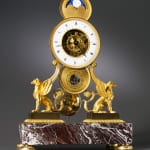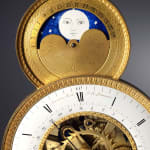Jean-Claude Lemoine
Literature
Pierre Kjellberg, “La Pendule Française du Moyen Age au XXe Siècle”, 1997, p. 321, pl. F, illustrating an almost identical clock also by Lemoine but with a rectangular base inlaid with mother of pearl.
A beautiful and very fine Empire gilt and patinated bronze mounted gilt brass and rubané campan marble skeleton clock of eight day duration by Jean-Claude Lemoine signed on the white enamel dial ring Invenit & Fecit J cl Lemoine à Paris, the main dial ring, with cut-out centre to reveal the elaborate movement within a gilt bronze beaded egg and dart bezel, with Roman numerals for the hours and outer Arabic numerals 15/30/45/60 for the minutes interspersed by diamond-shapes centred by a gilded bead for the intervening five minute intervals, with inner indications for the half beat seconds and within that Arabic numerals for the 31 days of the month, with a pair of Breguet style blued steel hands for the hours and minutes, a blued steel pointer for the sweep centre seconds and a further blued steel pointer for the calendar month. The main dial surmounted by a very fine lunar dial with very beautiful engine turned borders featuring a fine mottled blue and star-studded moon phase with upper markings for the 29 ½ days in the lunar month. With an additional calendar dial below the main dial with a very fine and unusual asymmetrically engine turned decoration enclosing at the base an outer ring marked with the abbreviated names of the days of the months and within that a further ring marked with theabbreviated names of the days of the week interspersed with their symbols, with a blued steel pointer for the calendar indications as well as a sweep centre blued steel pointer which at one end indicates the day of the week and at the other its associated symbol. The massive twin-barrel movement with pinwheel escapement, silk thread suspension, striking on the hour and half hours on a single bell, with a massive steel rod pendulum and large brass bob with a screw at its base to adjust the pendulum regulation. The magnificent case with a pair of outward facing seated griffins placed either side of the calendar dial seemingly supporting it and the main dial on the ends of their rosette tipped wings, the griffins with eagle heads and legs and body of a lion with scrolled acanthus-wrapped tails, both seated on rectangular patinated bronze plinth with a gilt bronze stiff leaf border placed upon a rectangular rubané campan marble base on four gilt bronze bun feet
Paris, date circa 1810
Height 50 cm, width 33 cm, depth 15 cm.
This imposing clock typifies the quality achieved by both Parisian clock and case makers during the early years of the nineteenth century in which a perfect marriage between horological excellence and aesthetics was achieved. As noted above, Pierre Kjellberg illustrates an almost identical skeleton clock which instead of having a marble base as here, the rectangular base is unusually inlaid with mother of pearl. Kjellberg identifies the maker of the latter clock as being Jean-Claude Lemoine, who we can also safely assume to be the same as the present maker for although it appears to be signed ‘J a Lemoine’, the letter ‘A’ is almost certainly composed of the lower case letters ‘C’ and ‘L’. According to Tardy, Jean-Claude Lemoine was born in 1750, he was apprenticed in 1765 and from 1778/9 until 1801, he worked from rue Montmartre in Paris. Tardy also notes that the name ‘Cde Le Moine à Paris’ appears on a Louis XVI clock, while here Lemoine proudly announced that he made and invented the present work. Elsewhere we find other clocks signed Lemoine à Paris including a Directoire gilt bronze mantle clock with case portraying Phaeton riding Apollo’s chariot, owned by the French government and housed at Château de Serrant. It is very likely that Jean-Claude Lemoine was the younger brother or at least closely related to the horloger-mécanicien François-Marie Lemoine who during the 1820s worked from 20 rue des Marais, Faubourg Saint Martin and in 1825 filed a patent for a musical instrument called Forte Campano which enabled soft sounds to be audible and perfectly imitated the sound of large bells.
One of the great appeals of the present clock is the arrangement of dials and the high quality engine-turned decoration on the subsidiary lunar and calendar dials. Either side of the latter are two magnificently cast and chased griffins with their head, wings and claws of an eagle and the body and hind parts of a lion. Imagery of these fabulous monsters probably originated in the ancient east, where with other imaginary beasts they guarded the gold of India. The ancient Greeks believed that griffins guarded the gold mines of the Scythians. Griffins are commonly portrayed in heraldry where they symbolise the combined qualities of the eagle and lion, namely watchfulness and courage.



